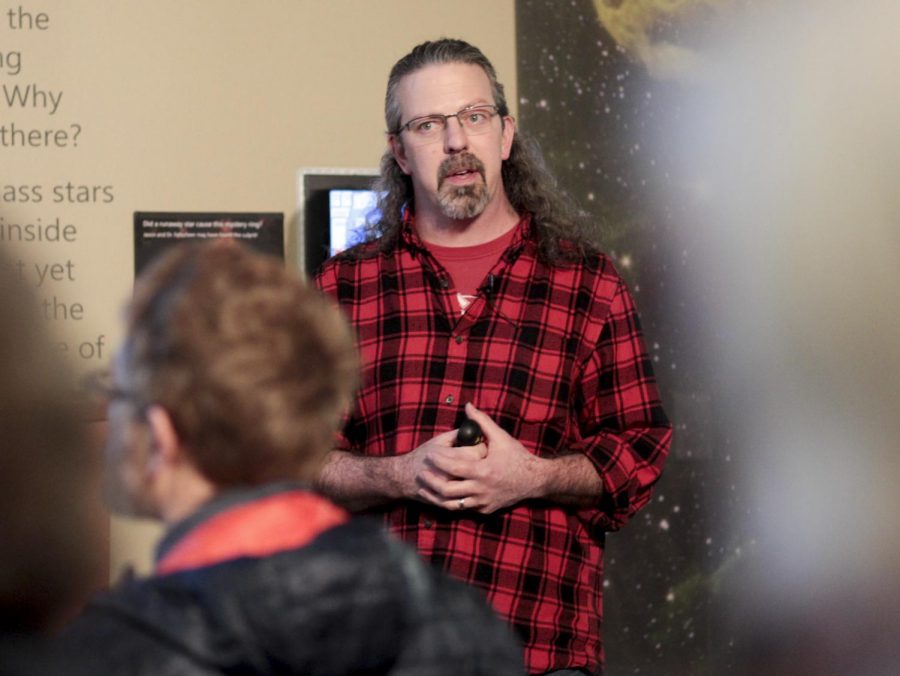Second climate discussion focuses on ecosystems
February 10, 2018
Around 60 community members and students gathered in the Dean Hall lobby for Fire and Ice II, a lecture and discussion on climate change in the Pacific Northwest last Thursday, Feb. 1. The lecture was hosted by the Museum of Culture and Environment.
Taking the podium first was Clay Arango, assistant professor in biological sciences and environmental studies. The presentation itself was officially titled “Forest Insects, Fires, Fish and Food in a Climate-Changed Yakima Basin,” and Arango began by disclosing that neither he nor Paul W. James, professor of biology, knew anything about fire or ice—at least within the scope of discussion.
Arango then began discussing the fundamentals of climate change, first by stating that the atmosphere has varied quite a bit in temperature and gas composition. According to Arango and backed up by data from the scientific community, atmospheric variation is currently off the charts. Sea ice has reduced by 40 percent over the last 40 years, and the sea level is rising at an alarming rate.
Arango then reduced the scale of climate change to the Pacific Northwest (PNW) region, stating that according to current trends and prediction models, the PNW is getting warmer and is seeing more precipitation. This means less snow, more rain, and hotter, drier summers.
Going into what he calls a “History of Forest (Mis)management,” Arango proved that he does know some amount about fires. He said that forest fires are a natural part of the ecosystem. He detailed how efforts in fire suppression have led to worse fires, as policies meant to prevent fires have led to an accumulation of dry vegetation, which fuels bigger fires when they eventually do happen.
This has unfortunately caused natural wildfires, which used to burn hot and fast, to become incredibly drawn out and hard to stop.
Last August, the Jolly Mountain Fire burned through 35,000 acres of forested land and caused over 150 households to be evacuated.
This doesn’t even touch on the effects that higher global temperatures are having on the frequency and strength of forest fires.
Fires, however, are not the only cause of deforestation.
Arango has been researching the western spruce budworm, a native species which feeds on trees in the PNW such as the Douglas fir. Worm damage in recent years has been on par with fire damage, with hundreds of thousands of acres destroyed.
According to Arango, the destruction from fire and worms goes hand in hand, as worms have far more of a food source and population boom when natural fires are prevented.
The second part of the presentation began when James took to the podium and turned the focus to another PNW staple which may be in danger as well: fish. Native fish populations, including salmon, have been on the decline.
James focused in on the endangered bull trout population, which has been on the decline with the increase in dams and fishing. Rising temperatures are expected to worsen this decline as well.
“Bull trout in the basin due to temperature are pretty much doomed,” James said.
However, all is not lost. There has been talk of new trout hatcheries and other plans to bring back the native populations.
Endangered fish species have been saved before. In the late 90s, many scientists thought salmon would be soon lost, but thanks to countless conservation efforts in the region, salmon population decline has been slowing and in many waterways the fish have begun to migrate again.
James said, “climate change will and is damaging salmon and other species.”
Flooding is another concern. James announced that last year’s flooding was an inconvenience and that future flooding will happen and it will be worse.
The flooding and the dryness of future summers puts many big parts of the Washington economy at risk. Apple orchards and wineries are in danger, as are hops.
Overall, James predicts change and potential danger in the future for Washington and Yakima Basin waterways.
There are solutions and plans, many aren’t favorable, such as a proposition made by an audience member to remove roads in forested areas so as to reduce the need for fire suppression.
Such a solution might work but would be a hard sell, as many people would lose access to forest areas. That doesn’t even mention a proposition made by Arango.
“Let’s just put a dam at the Yakima River Canyon, and turn the whole valley into a lake,” Arango said with a laugh.



